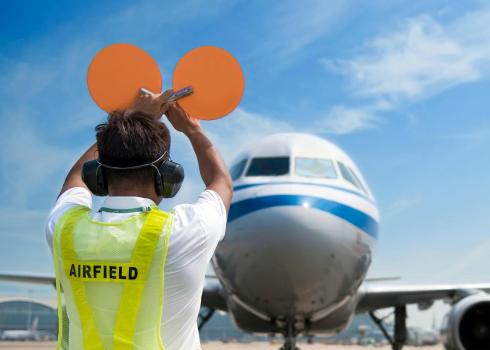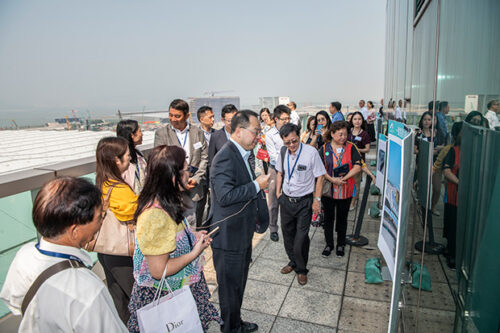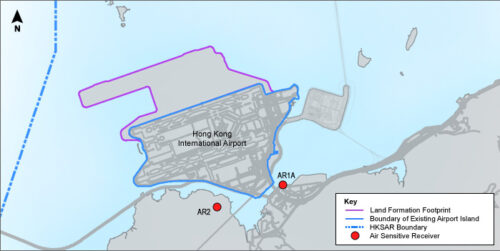
Airport expansion underway with Three Hong Kong Runways
By Megan Mentuck

With access to over 200 international destinations and roughly 71,500,00 passengers annually, Hong Kong International Airport is an aviation giant…and it’s about to get even bigger.
By 2024, Hong Kong International Airport is set to adopt a three-runway system (3RS) that will allow for more air travel to and from the already massive airport.
The three-runway system involves lots of new construction in order to achieve everything it hopes to.
Not only will there be a third runway added to the airport, but also HKIA (Hong Kong International Airport) hopes to add more optimization options to the airport experience for busy travelers, including revamping their luggage system and introducing an Automated People Mover or APM to help transport people throughout the different airport concourses.

To encourage proactive communication amongst communities in 2012, the Airport Authority set up 5 community liaison groups in the neighboring districts of HKIA: Islands, Kwai Tsing, Sha Tin, Tsuen Wan, and Tuen Mun.
Furthermore, the airport authority made visits to communities, schools, professional bodies, and individuals who can participate in the success of the project but also to ensure everyone is informed about the need for the expansion at this time.
Not Enough Land? Build More!

The Hong Kong International Airport is already partially built on reclaimed land.
This means that because there wasn’t enough space in the busy metropolitan hub of Hong Kong, the airport expanded into the water that surrounds the city, artificially creating more land.
Land reclamation started in Hong Kong started in the 1850s-1900s with towns like Six Tsuen Wan, Sha Tin, Tuen Mun, Tai Po, TseungKwan O, and Tung Chung as models.

Land reclamation can be achieved using a process known as deep cement mixing. This works by having a foundational material, like cement, injected into the ground where the land will be built. Then, on top of the sturdy foundation, sand or clay is filled into the desired height of the landmass.
Similar to the original construction of the Hong Kong International Airport, the Three-runway system requires land reclamation in the surrounding area to expand, as well.
The process is complicated and complex; however, necessary in the construction of the Three-runway system.

The Three-runway System: Explained
The Three-runway system project is a massive expansion project for Hong Kong International Airport.
It will introduce a third runway to the airport which is critical for meeting long-term air travel demand.
Although the HK$141.5 billion—or USD, $18 billion—price tag on the project may seem high, it’s important to note that the airport plays an important role in Hong Kong’s economy.
According to the official Hong Kong International Airport website, the airport supports all four pillars of the city’s economy: financial services, trading and logistics, tourism, and producing professional services.

Expansion of the airport via the Three-runway system is in fact an investment into the future of the airport and the city of Hong Kong—and one that they hope will pay off!
The Three-runway system will improve the airport’s efficiency by enabling each runway to have a specific function.
One runway will be designated for landings, one will be for takeoffs, and one will accommodate both. This system will optimize air travel to and from the Hong Kong International Airport.
Not Just Another Runway…
The Three-runway system project is essentially equivalent to building a whole other airport.
According to the Hong Kong International Airport website, beyond the creation of another runway, the project has seven core aspects to it.
These are: the creation of the third runway and additional taxiway systems, the reclamation of 650 hectares of land, the creation of the T2 concourse, the expansion of Terminal 2 and, the introduction of an Automated People

Mover; introduction of a Baggage Handling System; and the building of other associated airport infrastructure as needed.
The Automated People Mover
The Automated People Mover or APM is a 2600-meter-long system that will be added to connect Terminal 2 to the airport’s new passenger building. It will move up to 80 km/h or almost 50 mph.
The goal of the APM is to allow for easier transportation between different areas of the airport.
New Baggage Handling System
The new Baggage Handling System is also an important part of the airport’s expansion and updates.
It is designed to link Terminal 2 of the airport with what will be the new passenger building and be capable of handling 9,600 bags per hour.
This New Baggage Handling System will make baggage transportation throughout the airport more effective and efficient.
Hong Kong’s Commitment to Sustainability
The Three-runway system has pledged to commit to sustainability. One way that they have demonstrated this commitment is with their latest introduction of eco-enhanced seawalls.

The Marine Ecology and Fisheries Enhancement strategy was created to promote the betterment of the marine environment in the area and as one of their projects, introduced the idea of creating eco-enhanced seawalls for the airport.
In order to complete the airport’s expansion, they need to construct artificial seawalls to separate the airport on land from the sea.
To make this project more eco-friendly, rather than using regular concrete blocks, the Hong Kong International Airport proposed using eco-enhanced blocks.
The “eco-blocks” look similar to normal concrete blocks one would expect to see; however, there are design features carved into the blocks meant to provide small-scale pools and grooves for aquatic life in the area! This design feature is simple—yet environmentally friendly.
This is just one of the ways that Hong Kong International Airport is committing to a sustainable future in its creation of the Three-runway system.
Construction Timeline

Construction of the Three-runway system began in August 2016 and has been steadily underway since then.
According to the Hong Kong International Airport website, the project has been progressing on schedule and should be fully completed and operational by 2024.
The Three-runway system is very large and has many different components to it, so once it’s completed, it should provide a whole new experience for travelers at the Hong Kong International Airport.
One of the reasons why Hong Kong International Airport is so busy is because of its convenient location for international travel.
Being only a five-and-a-half-hour plane ride from most international stops, this airport is where frequent travelers find themselves.
So, if you are a frequent traveler and find yourself at the HKIA in the upcoming years, make sure to check out the new renovations!
- Airport Expansion: Hong Kong Set to Spend $18 Billion - June 26, 2023
- Visit the Stunning City of Berlin This Year - January 3, 2022
- Brattleboro Vermont: Arts Oasis - July 15, 2021




This article about the airport expansion in Hong Kong is really interesting! It’s fascinating to see how they’re planning to enhance the airport’s capacity and facilities to accommodate more travelers. As someone who loves to travel, I’m excited about the potential improvements that will make the airport experience even better. Can’t wait to see how it all unfolds! 🛫✈️